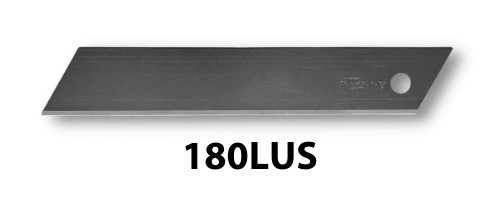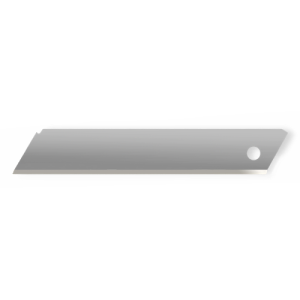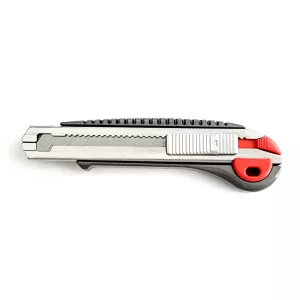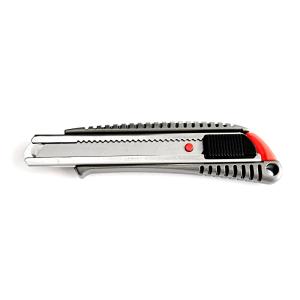How to Cut Foam Pipe Insulation with Aluminum Foil Layer
Kingspan Kooltherm pipe insulation Ø55mm and 100mm as an example
An important customer contacted us with the question: Do you have any knives or knife blades suitable for cutting phenolic foam pipe insulation with an aluminium foil layer? Generally about cutting insulation material The immediate response was that we likely had suitable knives, but we were surprised by how quickly the material wears down the blades. Our standard insulation knife blades 251 and 261 which are usually fantastic for rock wool insulation and foam plastic, didn't really work because they are too thick and stick and crumple the foam.
Difficulties in cutting phenolic foam insulation
A long, thin knife blade should be best. This is because the least amount of force is needed to penetrate the foam and a thinner, worn knife blade retains its sharpness better compared to a worn, thicker knife blade. The combination of sharpness and durability is required to penetrate the phenolic foam but also to retain the sharpness to cut the reinforced aluminium foil layer.
What is phenolic foam?
Phenolic foam is a good insulating foam. It is a thermosetting resin or a phenolic resin equivalent to Bakelite. Phenolic foam is made from phenol and formaldehyde and has a light pink-brown color. Thermosets do not melt but burn like solids. The materials are also, in some cases, what is known as self-extinguishing, so that the fire in the foam goes out unless energy is continuously supplied, e.g. by the continued burning of adjacent burning materials. The evolution from PUR to PIR and then phenolic foam has resulted in materials with better fire properties than ordinary foam.
Why is phenolic foam used for insulation?

The key issue for an insulation material is its poor thermal conductivity. Thermal conductivity is measured in W/mK (watts per metre Kelvin) and is referred to as the lambda value (λ). The lower the λ value, the poorer the thermal conductivity and the better the insulation performance.
Mineral wool in glass or stone wool has λ=0.034-0.040. Mineral wool has excellent sound insulation properties and is fire resistant. The disadvantages of mineral wool are that the material lacks moisture-buffering capacity and can condense moisture, which runs down and damages wooden structures. The fibers of mineral wool are unpleasant and the fibers can become detached and end up in the lungs through inhalation. In addition, mineral wool can smell foul and emit dangerous gases in the event of a fire. Insulation materials with phenolic foam have certain advantages. Kooltherm and SAFE-R, for example, have a lambda value of 0.020, which is almost twice as effective as materials such as mineral wool and foamed plastic. This means it insulates better and you can reduce the thickness of a wall by about 30 to 50%, which is an economic advantage because living space is valuable. Insulation materials with phenolic foam also have good fire properties and can be produced in a more climate-friendly way than mineral wool. Another important factor is that phenolic foam has a low weight and high load-bearing capacity.
Different phenolic foams to cut
Kingspan Insulation is a company that manufactures insulation materials. In Sweden they have a factory in Jönköping where they produce Kooltherm which is an insulation based on phenolic foam and Bakelite. Other insulation materials with phenolic foam are Therma, KoolDuct, Optim-R and SAFE-R. Phenolic foam insulation materials are very light due to their compact cellular structure. They are relatively simple to cut or saw but still create dust that can be harmful to breathe. To minimize dust, Sollex recommends cutting the phenolic foam with a knife blade rather than sawing with a toothed saw, which creates particles that should be avoided.
Why phenolic foam is difficult to cut
Two things make phenolic foam insulation difficult to cut. The material wears extremely on the knife blade so when the knife blade reaches the aluminium layer it is dull and tears the reinforced foil creating dust. When the foil tears, it results in the loss of crucial insulation surrounding the pipe.
Cutting pipe insulation in phenolic foam
The most important thing is to have a really sharp knife blade. To prevent the blade from sticking in the phenolic foam, it should be thin. The thickness of the blade should not be more than 0.5 mm. This means that the Sollex knife blade 251 for cutting cellular plastic is a bit too thick and unfortunately gets stuck in the phenolic foam before the reinforced aluminium foil is torn apart. A regular snap-off blade feels appealing because of the thickness and sharpness. However, there is a risk that segments of the blade will break off and injure the user. Therefore, Sollex recommends cutting blades without segments for cutting phenolic foam insulation material with reinforced aluminium foil. Sollex 180LUS (blade without segments) provides neat, precise cuts with a perfect surface and minimal dust.
Snap-off blade without segments 18mm 10pcs
Use one blade per cut and change blades when you have made a perfect cut in the pipe insulation. Probably the blade will last a few more cuts but you don't want to take a chance as a dull blade will not get through the reinforced aluminium foil, crumbling the phenolic foam and creating dust. Use good-quality knife blades that are not worn out halfway into the phenolic foam.
Cutting pipe bends for phenolic foam pipe insulation with reinforced aluminium foil To cut a 90-degree angle on a pipe bend in phenolic foam pipe insulation, cut the pipe lengthwise at a 45-degree angle. Mark the angle and slowly saw the knife blade through while following the marking. This will make one cut to make the angle into a 90 degree pipe bend. Then you reverse the cut surface and you get a 90 degree angle.
Recommendation for cutting phenolic foam pipe insulation with aluminium foil
After testing, we found that the Sollex no-break 180LUS blade worked well for cutting the phenolic foam and reinforced aluminum foil layer. Change the blade after each cut to keep it sharp for cutting the reinforced aluminium foil.
Best result: long thin razor blade without segments
Sources:
Framtidens Isolering - https://www.byggfaktadocu.se/f...
Kingspan Insulation - https://www.kingspan.com
Isoleringsmaterial från A till W - https://byggnadsvard.se/isoler...










